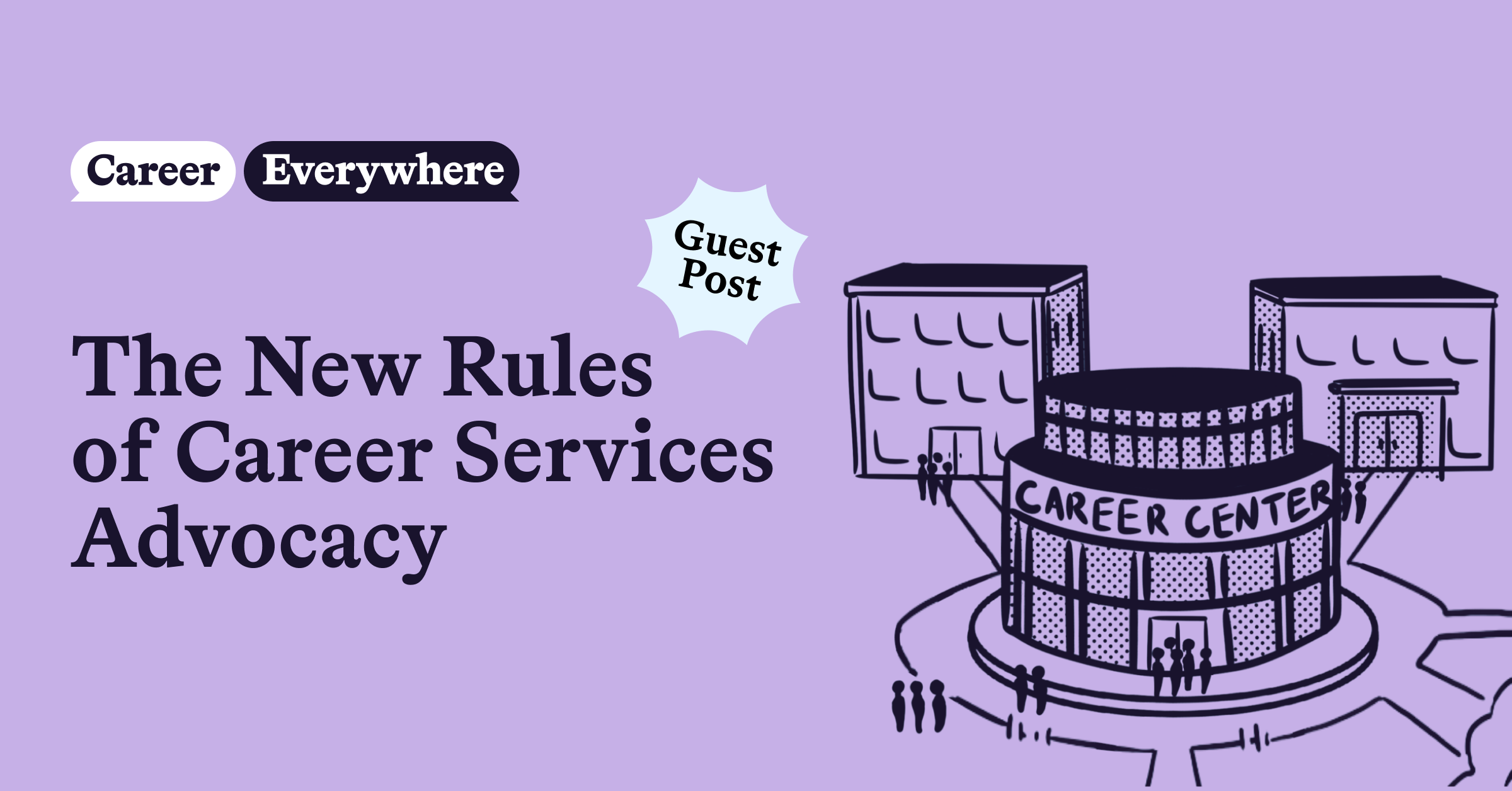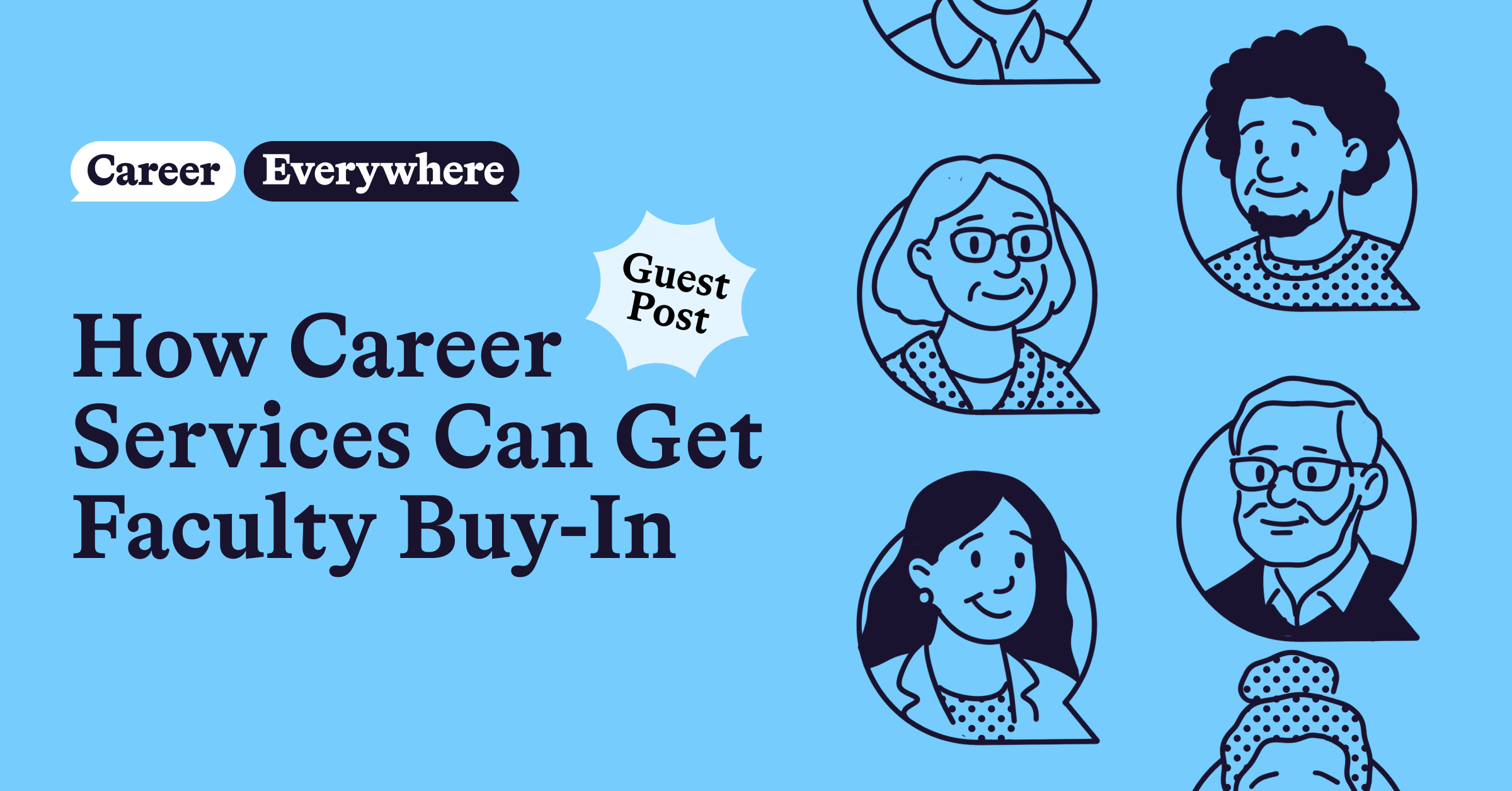
In today’s increasingly digital world, it’s become more important than ever for career services teams to build a dynamic, well-sourced, and accessible digital presence for their students.
Most career centers have a website, but often, those sites are static, outdated, and don’t efficiently pull all of a career team’s resources into the site. Or if the resources are on the site (like Handshake, for example), they require students to click on a link and then log into separate web pages to access each resource.
It’s not exactly a smooth user experience. Nor does it make career resources particularly accessible to anyone, anywhere, anytime—or what we call Career Everywhere.
That’s why more and more career centers are investing in and modernizing their websites and curating career resources based on students’ interests, backgrounds, and identities. That way, all student populations (not just the ones who can make it into a physical career center) can access resources and information 24/7/365.
Here are four ways to use your website to advance Career Everywhere.
Learn how uConnect’s virtual career center platform can help you make Career Everywhere a reality. Schedule a demo here.
What is Career Everywhere?
As we mentioned above, Career Everywhere is about making career services accessible to anyone, anywhere, anytime. And it boils down to three key tenets:
1. Engaging students with career resources before, during, and after college
Studies show that students are far more likely to build meaningful lives and careers if they engage with career services early and often throughout their college journey—and after they graduate. Career Everywhere is about being intentional with that engagement and trying new ways to drive awareness throughout the student lifecycle (or even before students officially enroll).
2. Providing truly equitable access to all students, 24/7/365
All students deserve access to career resources that will help them explore careers; participate in jobs, internships, and other micro-experiences; and ultimately, find meaningful work. Career Everywhere is about making those resources accessible to anyone, anywhere, anytime. It’s about making that experience equitable.
3. Shifting the role of career services from provider to facilitator
Career Everywhere is about empowering career services professionals to empower others on and off campus to have meaningful career conversations with students. This means that, rather than career centers being the sole provider of career services, they are facilitators. They start Career Champion programs, engage faculty and staff, embed career into curriculum, build allies across campus, teach faculty how to use the career center website, and more.
How to use your website to advance Career Everywhere
Your website is one of your most integral tools for the advancement of Career Everywhere because it democratizes access to all of your carefully sourced and curated resources.
Plus, your website is basically the front door to your office. It’s the first thing students, parents, and other stakeholders will look for when they want to learn about what you do, see how you can help them, or learn how to engage with you.
Here are four ways to use your website to advance Career Everywhere:
1. Put all of your career resources in one accessible place
With a fleshed-out website, you can put all of your career resources in one place that’s accessible 24/7/365.
And we’re not just talking about putting links to all of your resources on one webpage in an out-of-context, scattered way. We’re talking about pulling all of your resources into one place, where students can access them right there on your website, without having to leave your site to log in somewhere else.
For example, if you have a LinkedIn Learning subscription, you could pull the courses directly into your website. Or if you have Handshake, you could pull any job feed from Handshake into your website so students can see a dynamic, always up-to-date feed of jobs.
Or if you have Forage, you could pull their virtual job simulations directly into your website.
That way, students can always see what resources are available to them. Plus, it’s more accessible and equitable because all students have access to the resources—not just the students who can physically go into a career center.
And because it’s all in one place, it’s easier for students to find and it’s easier for career coaches to use in 1:1 appointments and recommend to students, faculty, staff, alumni, employers, families, and more.
Learn about other ways to use your website to improve equity and access in this article.
2. Build curated digital communities
Another way to use your website to advance Career Everywhere is to build curated digital communities for students based on their career interests and identities. With this method, students and other stakeholders can more easily find articles, videos, jobs and internships, events, data, and more that are relevant to them, specifically.
For example, the University of Washington Career and Internship Center has built dedicated community pages on their website based on career interests and identities.
UW’s career interest communities include:
- Arts/Media/Marketing
- Consulting/Business
- Health
- Nonprofit/Social Justice/Education
- Law/Government/Policy
- Physical and Life Sciences
- Sustainability/Conservation/Energy
- Tech/Data/Gaming
UW’s identity communities include:
- First-Generation Students
- International Students
- LGBTQ+ Students
- Students of Color
- Transfer Students
- Undocumented/DACA Students
- Student Veterans
- Students with Disabilities
Not only are curated digital communities a great way to get the right resources in front of the right students, but they’re also a great way to serve underrepresented students with content made specifically for them.
Learn more about how to serve underrepresented students with identity communities in this article or this podcast episode.
3. Integrate labor market data into your website
As we mentioned above, one key tenet of Career Everywhere is to make career resources accessible 24/7/365—and one of the most important resources to share with students is labor market data. This gives students a real-time grasp of what jobs and skills are most in demand, what average compensation ranges look like, who’s hiring, and more.
With tools like uConnect’s Labor Market Insights module, you can:
- Help students explore career paths (early and often throughout their college journey)
- Help students set salary expectations and negotiate job offers
- Help students target specific employers in their job search
- Build partnerships with faculty and staff
- Embed labor market data in your career communities
- Integrate labor market data into curriculum
- Add real-time data to your blogs and other resources
For example, the UMass Amherst Isenberg School of Management integrates labor market data into their website—and even includes instructions on how to use it.
With detailed analytics around today’s most in-demand jobs, compensation rates, top employers, and more at your fingertips, you can help students explore potential career pathways and plan for the future of work.
Learn more about how to use labor market data in your career center in this article.
4. Use your website to engage faculty and staff
Another way to use your website to advance Career Everywhere is to use it to engage faculty and staff. There are several ways to do this, but one particularly effective way is to build a page on your website specifically for faculty and staff.
That’s what the career centers at the University of Connecticut and the University of Miami have done—with much success!
The University of Miami Faculty and Staff Engagement Hub includes articles, trainings, videos, mentors, labor market data, career and industry guides, a faculty toolkit PDF, and more. The University of Connective Career Champions resources page also includes resources, trainings, articles, videos, labor market data, and a place to submit blog posts.
“We created the Hub to be a virtual meeting place for faculty and staff to connect with us and receive helpful information that can enhance the career conversations they are having both inside and outside of the classroom,” said Christian Garcia, Associate Dean and Executive Director of the Toppel Career Center at the University of Miami.
“We hope that through the Hub, we can showcase how easy it is to incorporate career into the curriculum and overall student experience at the University of Miami.”
By using your website to engage faculty and staff, you can shift your team from being the sole providers of career services to being the facilitators of career services (aka tenet three of the Career Everywhere movement!).
Learn more about how to engage faculty with career services in this article.
Conclusion
A career center’s website is one of the most integral tools for facilitating and advancing the Career Everywhere philosophy. It’s the metaphorical front door to your office where most students and other stakeholders go first to get career information and resources and learn about what you do. And it’s much more accessible than the physical career center.
If built correctly, a career center website can provide those valuable resources 24/7/365—and make career services accessible to anyone, anywhere, anytime.


